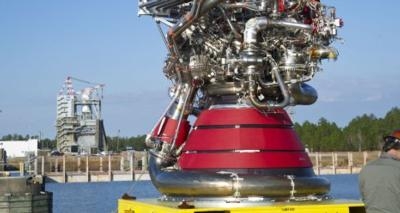Fri, Feb 15, 2013
Engine To Provide Thrust For The Heavy-Lift SLS
NASA's progress toward a return to deep space missions continues with a new round of upcoming tests on the next-generation J-2X rocket engine, which will help power the agency's Space Launch System (SLS). Beginning this month, engineers will conduct a series of tests on the second J-2X development engine, designated number 10002, on the A-2 Test Stand at NASA's Stennis Space Center in Mississippi. Once the series is completed, the engine will be transferred to the A-1 Test Stand to undergo a series of gimbal, or pivot, tests for the first time.

"The upcoming test series is not only a critical step forward, but important to the Stennis test team, as well," said Gary Benton, manager of the J-2X test project at Stennis. "This test series will help us increase our knowledge of the J-2X and its performance capabilities. In addition, the series will help us maintain the high skill level of our team as we look ahead to continued J-2X testing and testing of the RS-25 engines that will be used to power the SLS first-stage."
The first objective of the testing is to verify and demonstrate the engine's capability. Data from what is known as hot-fire engine tests will be compared to the performance of the first engine. Engineers also will vary liquid hydrogen and liquid oxygen inlet pressures and subject the engine nozzle to higher temperatures than in previous tests to see what effect they have on performance.
NASA already has conducted successful tests on engine number 10001 and on the J-2X powerpack assembly. In total, 34 tests were conducted on the J-2X engine and powerpack, with the J-2X achieving a full flight-duration firing of 500 seconds in the eighth test, earlier than any rocket engine in U.S. history. The engine is being designed and built by NASA and Pratt & Whitney Rocketdyne to power the upper stage of the 143-ton version of the SLS rocket.
The SLS will launch NASA's Orion spacecraft and other payloads from the agency's Kennedy Space Center in Florida.
(Image provided by NASA)
More News
Light Gun A handheld directional light signaling device which emits a brilliant narrow beam of white, green, or red light as selected by the tower controller. The color and type of>[...]
"The journey to this achievement started nearly a decade ago when a freshly commissioned Gentry, driven by a fascination with new technologies and a desire to contribute significan>[...]
Aero Linx: JAARS, Inc. For decades now, we’ve landed planes on narrow rivers and towering mountains. We’ve outfitted boats and vehicles to reach villages that rarely se>[...]
"Our driven and innovative team of military and civilian Airmen delivers combat power daily, ensuring our nation is ready today and tomorrow." Source: General Duke Richardson, AFMC>[...]
Aircraft Conflict Predicted conflict, within EDST of two aircraft, or between aircraft and airspace. A Red alert is used for conflicts when the predicted minimum separation is 5 na>[...]
 ANN's Daily Aero-Term (04.20.24): Light Gun
ANN's Daily Aero-Term (04.20.24): Light Gun Aero-News: Quote of the Day (04.20.24)
Aero-News: Quote of the Day (04.20.24) ANN's Daily Aero-Linx (04.21.24)
ANN's Daily Aero-Linx (04.21.24) Aero-News: Quote of the Day (04.21.24)
Aero-News: Quote of the Day (04.21.24) ANN's Daily Aero-Term (04.21.24): Aircraft Conflict
ANN's Daily Aero-Term (04.21.24): Aircraft Conflict



